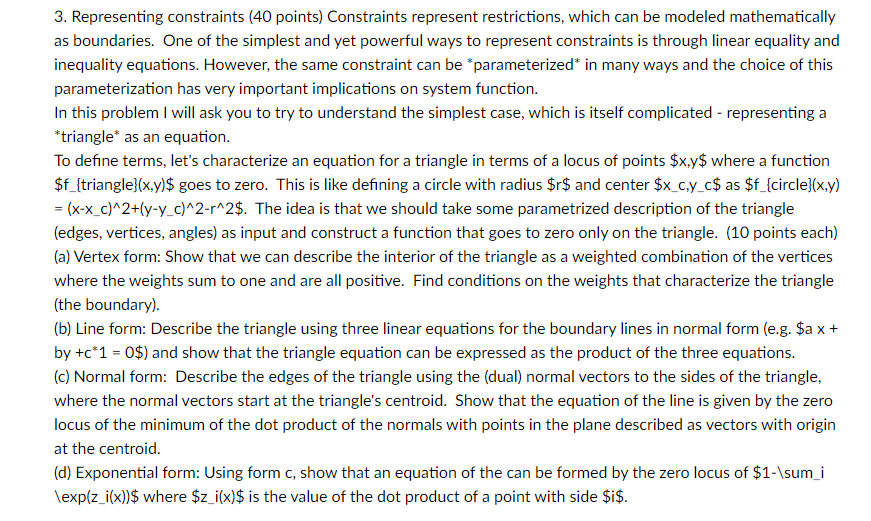Answered step by step
Verified Expert Solution
Question
1 Approved Answer
3. Representing constraints (40 points) Constraints represent restrictions, which can be modeled mathematically as boundaries. One of the simplest and yet powerful ways to

3. Representing constraints (40 points) Constraints represent restrictions, which can be modeled mathematically as boundaries. One of the simplest and yet powerful ways to represent constraints is through linear equality and inequality equations. However, the same constraint can be *parameterized* in many ways and the choice of this parameterization has very important implications on system function. In this problem I will ask you to try to understand the simplest case, which is itself complicated - representing a *triangle* as an equation. To define terms, let's characterize an equation for a triangle in terms of a locus of points $x,y$ where a function $f_{triangle}(x,y)$ goes to zero. This is like defining a circle with radius $r$ and center $x_c.y_c$ as $f_{circle}(x,y) = (x-x_c)^2+(y-y_c)^2-r^2$. The idea is that we should take some parametrized description of the triangle (edges, vertices, angles) as input and construct a function that goes to zero only on the triangle. (10 points each) (a) Vertex form: Show that we can describe the interior of the triangle as a weighted combination of the vertices where the weights sum to one and are all positive. Find conditions on the weights that characterize the triangle (the boundary). (b) Line form: Describe the triangle using three linear equations for the boundary lines in normal form (e.g. $a x + by +c*1 = 0$) and show that the triangle equation can be expressed as the product of the three equations. (c) Normal form: Describe the edges of the triangle using the (dual) normal vectors to the sides of the triangle, where the normal vectors start at the triangle's centroid. Show that the equation of the line is given by the zero locus of the minimum of the dot product of the normals with points in the plane described as vectors with origin at the centroid. (d) Exponential form: Using form c, show that an equation of the can be formed by the zero locus of $1-\sum_i \exp(z_i(x))$ where $z_i(x)$ is the value of the dot product of a point with side $i$.
Step by Step Solution
There are 3 Steps involved in it
Step: 1
The image contains a text which appears to be a math problem that discusses representing constraints specifically focusing on representing a triangle as an equation in a variety of forms vertex form l...
Get Instant Access to Expert-Tailored Solutions
See step-by-step solutions with expert insights and AI powered tools for academic success
Step: 2

Step: 3

Ace Your Homework with AI
Get the answers you need in no time with our AI-driven, step-by-step assistance
Get Started


